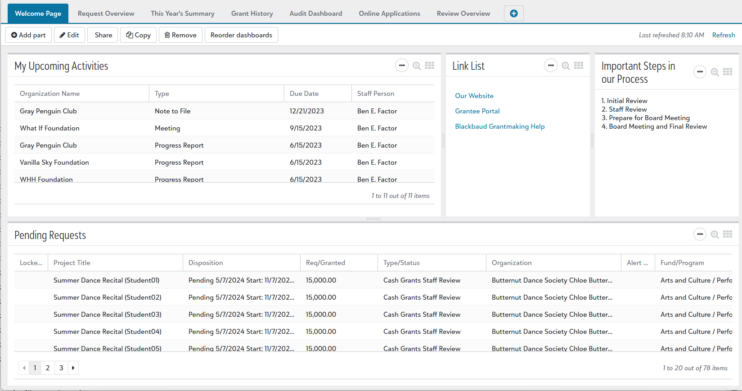Don’t Let Staff Turnover Affect Your Grantmaking Data Quality

Working in the nonprofit sector is hard. You and your grantees are driven by a passion for your mission that sometimes leads to burnout. And salaries in many nonprofit organizations can’t compete with the for-profit sector.
According to The Council of Nonprofits 2023 Nonprofit Workforce Survey, almost three quarters of nonprofits that completed the survey have current openings at their organization.
Hiring and staff turnover are common occurrences for nonprofits and grantmaking organizations. This can cause problems when tasks fall through the cracks or emails go to inboxes that no longer exist. As a grantmaking organization focused on the success of your grantees, it is essential to have a process in place to manage personnel changes—for both you and your grantees—so everyone stays informed and on schedule.
Here are some best practices for effectively managing staff turnover and onboarding with your grantmaking software, including some methods of reassigning existing records to new staff members, establishing clear security roles, and building a comprehensive policies and procedures guide to keep everyone on the same page.
1. Update Assigned Tasks
One major pitfall to avoid during periods of staff turnover at your grantmaking organization is leaving ongoing activities or requests assigned to people who no longer work there. Action items not assigned to an active team member can lead to phone calls, meetings, and other crucial tasks not being completed.
Ensure your team has a standard procedure for identifying any requests and activities within your system that are still assigned to departing team members. Queries and reporting tools will provide an efficient means of building a list of relevant activities.
Consider building queries like “All pending requests assigned to staff member X” or “all open Activities assigned to staff member X.” Be sure to save those query results so they can be reused, or even use an export tool if you need to share it with other users.
Some solutions like Blackbaud Grantmaking even have a batch update tool that enables users to make global changes to a group of records. This is an ideal means of efficiently reassigning a batch of requests or activities to a new staff member.
2. Create a Policies and Procedures Manual
Once a new employee joins your team, having a comprehensive document outlining standard procedures for data entry will make that transition much easier on both the individual and the staff members training them.
Record that institutional knowledge in an accessible Policies and Procedures manual. This effective guide will be a comprehensive blueprint to working at your organization, including links to relevant resources, steps for data entry, and flow charts outlining who is responsible for which tasks. This document will help new team members absorb your unique grantmaking process and keep everyone on the same page. And be sure to update your Policies and Procedures guide annually to ensure information is up to date for current and future staff members.
Create a link to the guide anywhere that would be convenient for your team members to find, such as on your organization’s internal website or in a Links tile on your grant management system dashboard.
3. Potential items to include within an effective Policies and Procedures Guide:
Links to internal resources within your organization
- Guidelines on who to contact for certain types of questions
Links to external resources
- Contact information for your grantmaking software’s technical support
- Links to resources for users of your grantmaking software, such as its community, training resources, or FAQs
A glossary of terms your team uses in your grantmaking software
- A list of Request Types
- A list of Request Statuses
- A list of coding sheets organized by record type
- A list of custom fields organized by record type
A clear structure for your team’s grantmaking process
- The responsibilities for each team member
- List of documents and requirements needed for requests
- Timeline for reviewing requests
- Who is responsible for managing Online Applications?
4. Provide “Goldilocks” Security Access
Of course, when someone leaves your organization, you have a process to make sure they no longer have access to your system. When a new person comes on, it’s a good time to understand exactly what access they need.
Evaluate the tasks the new user will perform regularly before handing over keys to the system. Consider reporting access, administration rights, ability to edit communication templates, or handling applications. Does everyone get full access? Likely no.
A user should only have the “goldilocks” of security access: not too much and not too little. Consider the level of database training the user has. If they are not trained on a powerful feature—or one with access to sensitive personal information—it is best to not provide access now.
To make this an easier transition for the future, document in your organization’s policies the appropriate access rights assigned for all staff roles. Be sure you’ve properly documented how to inactivate access to the database for staff members who leave the organization, too.
Blackbaud Grantmaking user? Here is a document that outlines the different security roles available in the system.
5. Verify System Usage
Once a new user begins to access the system, check in after a few weeks to make sure your new staff member feels comfortable in the system. This should be both a qualitative check-in by asking them directly and a quantitative check-in by auditing their system usage.
Rely on record fields such as “added by,” “changed by,” or “changed by date” in your software’s query tool. Or use an auditing search tool within your GMS to specifically group data based on creation date, creation user, among other options. Tap a more experienced team member to review the new member’s work to ensure the new staff member is following your organization’s data management best practices.
6. Set Up Personalized Dashboards
You can also help new staff gear up for a productive day and keep track of priorities with a personalized dashboard. This information headquarters is a great home page for GMS users.
If your organization’s GMS has a variety of dashboard parts, get creative with how they can be used. Give the user access to tables, graphs, and lists most relevant to their work. Some systems, like Blackbaud Grantmaking, even enable admins to build and edit dashboards on behalf of other users in the Control Panel, an ideal way to set up new staff members with everything they need to know on day 1.
The dashboard can also serve as a hub for important contacts and links. Use a text or link dashboard part to display GMS support links, how-to articles, policies and procedures, or even phone numbers and status pages for your GMS. Imagine having this toolkit of resources at your fingertips!

Admins can also set up new users with prebuilt queries and activities so they can easily access data and tasks. For example, build and save a query of requests that display important details like grantee name, requested amount, project title, project description, project start date, and review notes. Make sure others can access this saved list.
And be sure to assign phone calls, meetings, and other tasks to new users in the form of activity records. A dashboard component could display activities assigned to the new staff member scheduled for the upcoming weeks. Establish and communicate policies for the user to revisit the activity record for updating new details and marking as complete.
Practice Good Database Maintenance to Simplify Staff Changes
Following these steps will help your organization manage staff turnover and keep your database up to date! Don’t forget that database maintenance is not “set it and forget it.” It is a constant process of updating and verifying. By making sure you have the right processes and best practices in place, you have accurate, up-to-date information even as your staff changes!
Are you ready for a grantmaking solution that helps your organization manage your data simply and efficiently? Check out our latest Blackbaud Grantmaking product tour to learn how the right GMS can save you time and help you drive more impact.
Blackbaud University Instructor Chrissy Haskell also contributed to this article.
